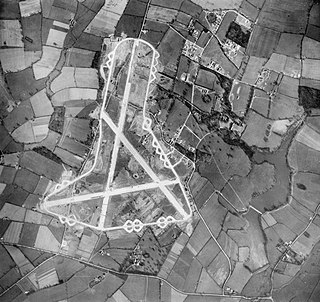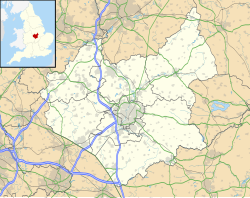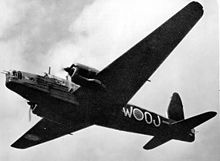
Husbands Bosworth is a large crossroads village in South Leicestershire on the A5199 road from Leicester city to Northampton and the A4304 road from Junction 20 of the M1 motorway to Market Harborough. The population of the village was 1,027 at the 2011 census.

Royal Air Force Gaydon or more simply RAF Gaydon is a former Royal Air Force station located 5.2 miles (8.4 km) east of Wellesbourne, Warwickshire and 10.8 miles (17.4 km) north west of Banbury, Oxfordshire, England.

Royal Air Force Elgin or more simply RAF Elgin also known as Bogs of Mayne is a former Royal Air Force satellite station located approximately 1.5 kilometres south west of Elgin in Moray, Scotland. It opened in 1940 as a satellite airfield of RAF Lossiemouth and was used throughout the Second World War, predominantly by bomber aircraft of No. 20 Operational Training Unit. Towards the end of the war it was used by No. 46 Maintenance Unit, before it closed in 1947. The site was returned to agricultural use, although several airfield buildings and a memorial remain.

Turweston Aerodrome is an airfield located near the village of Turweston, in north Buckinghamshire near the Northamptonshire border. It is a former Royal Air Force Second World War bomber training facility, now a business park and airfield which is home to the Light Aircraft Association.
Royal Air Force Bircotes or more simply RAF Bircotes is a former Royal Air Force satellite station located within South Yorkshire, England. Although it was named after the village of Bircotes which is in Nottinghamshire.
Royal Air Force Bramcote, or more simply RAF Bramcote, is a former Royal Air Force station located 3.5 miles (5.6 km) south-east of Nuneaton, Warwickshire, England used during the Second World War. It was later transferred to the Admiralty and was known as Royal Naval Air Station Bramcote,, and when commissioned became HMS Gamecock. When it subsequently transferred to the British Army from the Admiralty, it was called Gamecock Barracks.

Royal Air Force Long Marston or more simply RAF Long Marston is a former Royal Air Force satellite station, that was opened in 1941 in the county of Warwickshire.

Royal Air Force Haverfordwest or more commonly RAF Haverfordwest, is a former Royal Air Force station located 2.1 miles (3.4 km) north of Haverfordwest, Pembrokeshire and 11 miles (18 km) south of Fishguard, Pembrokeshire, Wales.
Royal Air Force Honeybourne, or more simply RAF Honeybourne, was a Royal Air Force station located 0.6 miles (0.97 km) south of Honeybourne, Worcestershire, England and 4.6 miles (7.4 km) east of Evesham, Worcestershire, England

Royal Air Force Cheddington or more simply RAF Cheddington is a former Royal Air Force station located 1 mile (1.6 km) south-west of Cheddington, Buckinghamshire, England. The airfield was closed in 1952.

Royal Air Force Lichfield or more simply RAF Lichfield is a former Royal Air Force station located in Fradley, 2 miles (3.2 km) north east of Lichfield, Staffordshire, England. The airfield was the busiest airfield in Staffordshire during the Second World War. The airfield supported its own units as well as providing safe haven for many more. It was a control point for all aviation traffic that passed through the Birmingham area during the war and saw more aircraft movements than any other Staffordshire airfield.

Royal Air Force Balado Bridge or more simply RAF Balado Bridge is a former Royal Air Force satellite station located 2 miles west of Kinross, in central Scotland. It opened in 1942 as a satellite airfield to RAF Grangemouth, and closed in 1957. It has since served as a NATO satellite station, a microlight flying base, and as the venue for the T in the Park music festival.

RAF Atherstone was a former Royal Air Force satellite station located 2.25 miles (3.62 km) south of Stratford-upon-Avon, Warwickshire, England, 7.5 miles (12.1 km) north-west of Shipston on Stour.
Royal Air Force Bitteswell or more simply RAF Bitteswell is a former Royal Air Force satellite station located 2.0 miles (3.2 km) west of Lutterworth, Leicestershire and 6.1 miles (9.8 km) north of Rugby, Warwickshire, England.

No. 3 (Coastal) Operational Training Unit RAF, was a training unit of the Royal Air Force, within No. 17 Group RAF, which was part of RAF Coastal Command. The unit started operating from late 1940 and disbanded at the start of 1944, being absorbed into No. 6 OTU.

Royal Air Force Ossington or more simply RAF Ossington is a former Royal Air Force station located near the village of Ossington, Nottinghamshire, England.
Royal Air Force Chipping Warden or more simply RAF Chipping Warden was a Royal Air Force station located 6 miles (10 km) north-east of Banbury near the village of Chipping Warden, Northamptonshire, England.

Royal Air Force Hixon or more simply RAF Hixon is a former Royal Air Force station located on the north western edge of the village of Hixon in Staffordshire, England. The airfield was 7.5 miles (12.1 km) east of Stafford and bounded at the west and north by railways.

Royal Air Force Husbands Bosworth or more simply RAF Husbands Bosworth is a former Royal Air Force satellite station near the village of Husbands Bosworth in the county of Leicestershire, England.

No. 5 (Coastal) Operational Training Unit RAF, was a training unit of the Royal Air Force, within No. 17 Group RAF, which was part of RAF Coastal Command. The unit was established during August 1941 and disbanded during August 1945.

















